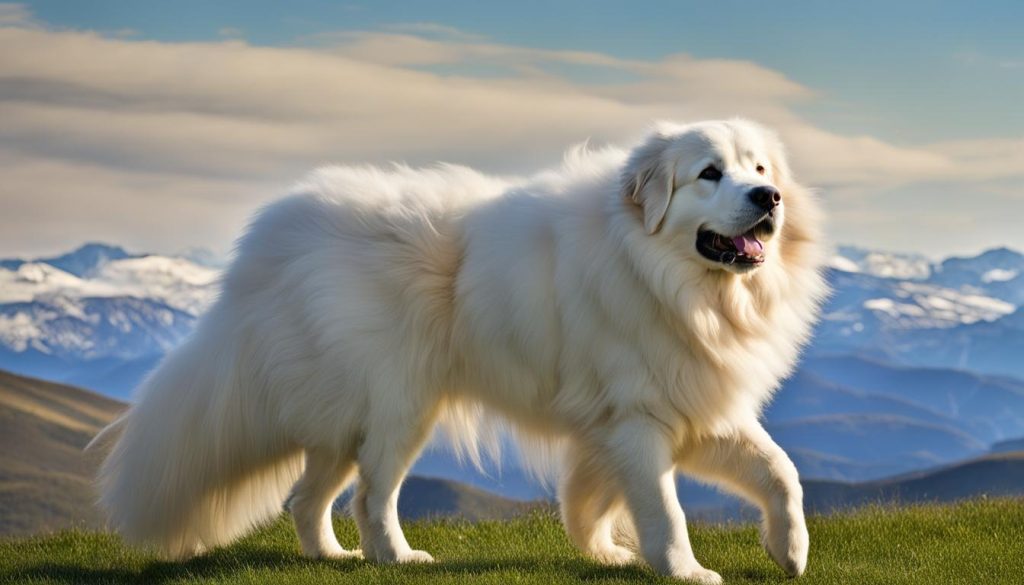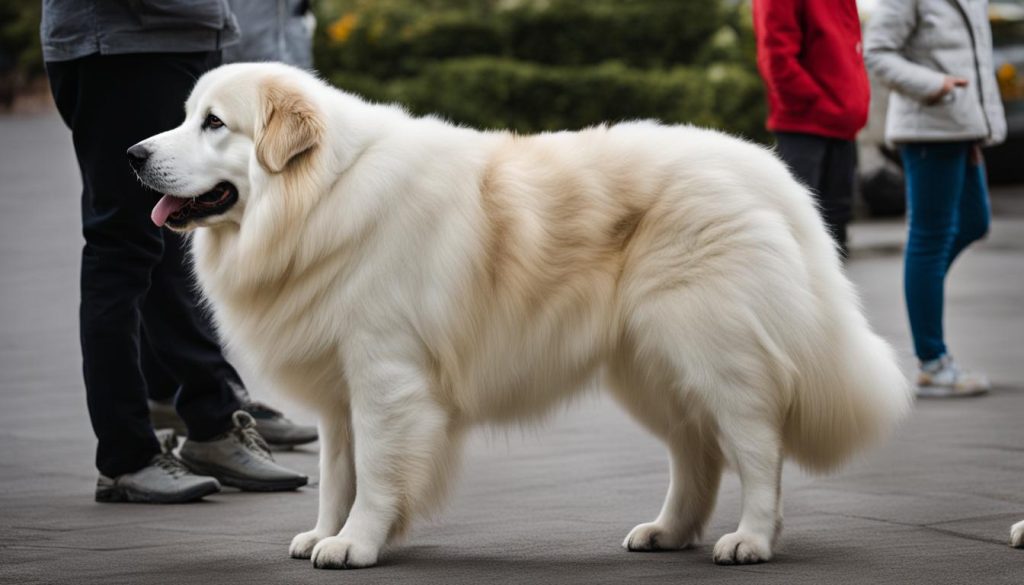Training a Great Pyrenees can be a challenging but rewarding experience. As a dog owner, I understand the importance of effective training techniques in shaping our furry companions into well-behaved and obedient pets. In this article, I will share with you some valuable tips and tricks for mastering Great Pyrenees training.
When it comes to Great Pyrenees training or any other dog, positive reinforcement is key. By using rewards and praise instead of punishment, you can create a positive learning environment and strengthen the bond between you and your furry friend. Positive reinforcement not only motivates your Great Pyrenees to learn but also helps in addressing any behavioral issues that may arise during the training process.
Obedience training plays a crucial role in the overall development of your Great Pyrenees. Teaching them basic commands such as sit, stay, recall, down, and leave it can ensure their safety and well-being. Consistency and repetition are essential in reinforcing these commands. By making training sessions fun and engaging, you can keep your Great Pyrenees interested and eager to learn.
Great Pyrenees Training
- Positive reinforcement is crucial in Great Pyrenees training.
- Obedience training helps ensure the safety and well-being of your Great Pyrenees.
- Consistency and repetition are key in reinforcing basic commands.
- Creating a positive learning environment fosters effective training.
- Addressing behavioral issues promptly contributes to a successful training experience.
Understanding Great Pyrenees Breed Traits
Before you embark on Great Pyrenees training, it is crucial to have a solid understanding of their breed traits. Great Pyrenees are renowned for their intelligence, loyalty, and protective instincts. These magnificent dogs were originally bred to guard livestock, which can sometimes present unique training challenges.
Great Pyrenees exhibit remarkable intelligence, making them quick learners. They have an innate ability to understand and respond to commands, which can be harnessed to your advantage during the training process.
Loyalty is another characteristic that defines the Great Pyrenees breed. These dogs form deep bonds with their families and are highly dedicated and devoted to their owners. This loyalty can foster a strong connection between you and your Great Pyrenees, facilitating the training journey.
Great Pyrenees also possess strong protective instincts, a trait deeply ingrained in their genetics. They have a natural inclination to protect their loved ones, which can be both beneficial and challenging during training. It’s crucial to strike a balance between their protective nature and their ability to follow commands.
It’s important to be mindful of these specific breed traits when training your Great Pyrenees. Tailoring your training techniques to suit their needs will go a long way in ensuring a successful training experience. By understanding their intelligence, loyalty, and protective instincts, you can develop a training approach that maximizes their potential while addressing any challenges that may arise.

Tips for Creating a Positive Training Environment
Creating a positive training environment is essential for effective Great Pyrenees training. To set your furry friend up for success, follow these tips:
- Gather all the necessary training supplies to ensure smooth sessions. You’ll need a leash, treats, and a clicker.
- Find a quiet and distraction-free area where you can focus on training your Great Pyrenees. This will help them stay engaged and avoid unnecessary distractions.
- Establish yourself as the pack leader by setting clear boundaries and expectations. Dogs thrive in a structured environment with consistent leadership.
- Build a strong bond with your Great Pyrenees. It’s important for them to trust and respect you as their trainer.
- Motivate your dog to learn by using positive reinforcement techniques. Praise, treats, and rewards will encourage your Great Pyrenees to exhibit desired behaviors.
A positive training environment not only fosters learning but also strengthens the bond between you and your Great Pyrenees. With the right supplies, motivation, and leadership, you’ll create an atmosphere where your dog can thrive.
Teaching Basic Training Commands
Teaching your Great Pyrenees basic training commands is essential for their safety and overall well-being. By mastering commands like sit, stay, recall, down, and leave it, you can ensure clear communication and reinforce their obedience. Here’s how to get started:
- Sit: Begin by holding a treat close to your dog’s nose, then move your hand up, causing their head to follow the treat and their bottom to lower. Once they’re in a sitting position, say the command “sit” and reward them with the treat and praise.
- Stay: Start with your dog in a sitting position. Hold your hand up, palm facing towards them, as if signaling them to stop. Gradually take a few steps back while maintaining eye contact. If they remain in place, reward them with a treat and praise, using the command “stay”. Slowly increase the distance and duration of the stay over time.
- Recall: Begin in a controlled environment with minimal distractions. Call your dog’s name followed by the command “come” or “recall”. When they come to you, reward them with a treat and praise. Gradually increase the distance and distractions as they become more reliable in their recall.
- Down: Start with your dog in a sitting position. Hold a treat in your hand near their nose and then slowly move it towards the ground. Guide them into a lying-down position while saying the command “down”. Once they are in the down position, reward them with the treat and praise.
- Leave it: Hold a treat in one hand and close your hand into a fist. Show the closed fist to your dog and say the command “leave it”. Wait for them to lose interest or ignore the closed fist and reward them with a treat from your other hand, along with praise. As they progress, you can introduce more tempting objects and reinforce the “leave it” command.
Remember, consistency is key when teaching basic training commands. Practice these commands regularly, using positive reinforcement techniques such as treats and praise. With time and dedication, your Great Pyrenees will become well-versed in these essential commands, ensuring their safety and enhancing the bond between you.

Conclusion
Great Pyrenees training requires patience, consistency, and a positive approach. Understanding their breed traits and creating a positive training environment are key elements in achieving successful results. By using positive reinforcement techniques and teaching them basic training commands, you can establish a strong bond and ensure your Great Pyrenees becomes a well-behaved and obedient companion.
During the Great Pyrenees training process, it is important to consistently use positive reinforcement to reward desired behaviors. This approach not only motivates your Great Pyrenees, but also strengthens the bond between you and your furry friend. By offering treats, praise, and affection, you can reinforce obedience and create a positive association with training.
Additionally, it is crucial to establish yourself as the pack leader and provide consistent guidance. Set clear boundaries and rules for your Great Pyrenees, and address any behavioral issues promptly. By doing so, you can address any challenges that may arise and ensure a successful training experience.
In conclusion, with dedication and effective training techniques, you can have a well-behaved and obedient Great Pyrenees. Remember to be patient, consistent, and positive in your approach. By focusing on obedience, positive reinforcement, and behavioral guidance, you can shape your Great Pyrenees into the perfect companion.
FAQ
What are some important tips for effective Great Pyrenees training?
Some important tips for effective Great Pyrenees training include understanding their breed traits, creating a positive training environment, using positive reinforcement techniques, establishing clear boundaries, and addressing any behavioral issues that may arise.
What are the specific traits of Great Pyrenees that affect their training?
Great Pyrenees are known for their intelligence, loyalty, and protective instincts. These traits can sometimes present training challenges, but by tailoring your training techniques to their needs, you can overcome these challenges and have a successful training experience.
How can I create a positive training environment for my Great Pyrenees?
To create a positive training environment for your Great Pyrenees, gather all the necessary training supplies, such as a leash, treats, and clicker. Find a quiet and distraction-free area for training, establish yourself as the pack leader, and motivate your dog to learn using positive reinforcement techniques and clear boundaries.
What basic training commands should I teach my Great Pyrenees?
Some basic training commands you should teach your Great Pyrenees include sit, stay, recall, down, and leave it. Use positive reinforcement techniques, such as treats and praise, to reward your dog for following these commands. Regular practice will help establish clear communication and reinforce their obedience.






